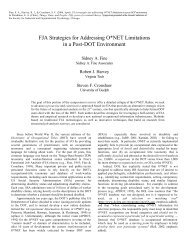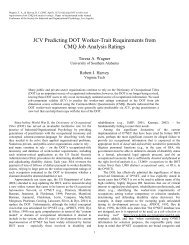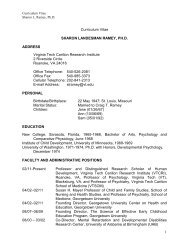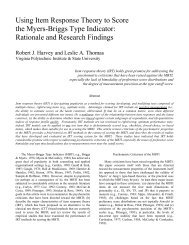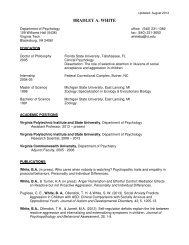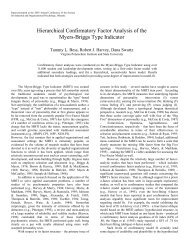Curriculum Vitae - Psychology Department - Virginia Tech
Curriculum Vitae - Psychology Department - Virginia Tech
Curriculum Vitae - Psychology Department - Virginia Tech
You also want an ePaper? Increase the reach of your titles
YUMPU automatically turns print PDFs into web optimized ePapers that Google loves.
12<br />
Whiteside, S. P., & Ollendick T. H. (2009). Developmental perspectives on anxiety classification. In D<br />
McKay, J. S. Abramowitz, S. Taylor, & G.J.G. Asmundson (Eds.). Current perspectives on the anxiety<br />
disorders: Implications for DSM-V and beyond (pp. 303-325). New York: Springer.<br />
Costa, N.M., Benoit, K.E., & Ollendick, T.H. (2010). Interpersonal issues in treating children and<br />
adolescents. In L.M. Horowitz & S. Strack (Eds.), Handbook of interpersonal psychology (pp. 493-508).<br />
New York: John Wiley & Sons.<br />
Cowart, M. J. W., & Ollendick, T. H., (2010). Attentional biases in children: Implication for treatment. In<br />
J. A. Hadwin & A. P. Field (Eds.), Information processing biases and anxiety: A developmental<br />
perspective (pp. 297-319). Oxford: Oxford University Press.<br />
Murrihy, R.C., Ollendick, T.H., & Kidman, A.D. (2010). Epilogue: Future directions in research and<br />
practice for conduct problem youth. In R.C. Murrihy, A.D. Kidman, & T.H. Ollendick (Eds.), Handbook<br />
of clinical assessment and treatment of conduct problems in youth (pp. 517-530). New York: Springer.<br />
Ollendick, T. H., Costa, N. M., & Benoit, K. E. (2010). Interpersonal processes and the anxiety disorders<br />
of childhood. In G Beck (Ed.), Interpersonal processes in the anxiety disorders: Implications for<br />
understanding psychopathology and treatment (pp. 71-95). Washington, DC: APA Books.<br />
Ollendick, T. H., Davis III, T. E., & Reuther, E. T. (2010). Specific phobias. In M. Gomar, J. Mandil, &<br />
E. Bunge (Eds), Manual de terapia cognitiva comportamental con ninos y adolesccentes (Manual of<br />
cognitive and behavior therapies for children and adolescents) (pp. 241-266). Polenmos, Buenos Aires,<br />
Argentina.<br />
Ollendick, T. H., & Hannesdottir, D. (2010). Separation anxiety and panic disorder in children and<br />
adolescents. In L. G. Öst (Ed.), Kognitiv beteendeterapi inom barn-och ungdomspsykiatrin (Cognitive<br />
behavior therapy in child and adolescent psychiatry) (pp. 95-109). Stockholm, Sweden: Natur & Kultur.<br />
Ollendick, T. H., & Hovey, L. D. (2010). Intervention and treatment for children and adolescents:<br />
Anxiety disorders. In J. C. Thomas & M. Hersen (Eds.), Handbook of clinical psychology competencies<br />
(Vol. 3, pp. 1219-1244). New York: Springer.<br />
Wolff, J.C., & Ollendick, T.H. (2010). Conduct problems in youth: Phenomenology, classification, and<br />
epidemiology. In R.C. Murrihy, A.D. Kidman, & T.H. Ollendick (Eds.), Handbook of clinical assessment<br />
and treatment of conduct problems in youth (pp. 3-20). New York: Springer.<br />
Davis, III, T. E., & Ollendick, T. H. (2011). Specific phobias in children and adolescents. In D. McKay &<br />
E. A. Storch (Eds.), Handbook of child and adolescent anxiety disorders (pp. 231-244). New York:<br />
Springer.<br />
Ollendick, T. H., & King, N. J. (2011). Evidence-based interventions for youth. In P. J. M. Prins, J. D.<br />
Bosch, & C. Braet (Eds.). Methods and techniques of behavior therapy for children and youth (2 nd ed.).<br />
Springer Media: Houten, Netherlands.<br />
Ollendick, T. H., & Shirk, S. R. (2011). Clinical interventions with children and adolescents: Current<br />
status, future directions. In D. H. Barlow (Ed.), Oxford handbook of clinical psychology (pp.762-788).<br />
Oxford: Oxford University Press.<br />
Cunningham, N. R., Ollendick, T. H., & Jensen, P. S. (2012). Weighing evidence for common and<br />
specific factors in psychotherapy with children. In R. D. Alarcon and J. B. Frank (Eds.), The





